|
|
Release Notes
One of 270 bottles drawn from a single Amontillado Sherry Hogshead in November of 2024. Originally distilled in 2012. Finished in the Amontillado Hogshead for 4 years since 2020.
From the Bottle
This Highland dram from Glen Garioch distillery spent the last 4 years of maturation in an Amontillado cask. This time spent maturing has instilled notes of dark chocolate, brandy beans, tangerines and date & walnut cake.
This bottling will be available in the following markets: Germany, the USA and the UK.
This bottling will be available in the following markets: Germany, the USA and the UK.
Cadenhead's
3rd Party Tasting Notes
Nose: Dark chocolate, orange essence, dates, prunes, brandy beans.
Flavour: Pecans, tangerines, hazelnuts.
Finish: Raisins, nougat, date & walnut cake, caramel.
Flavour: Pecans, tangerines, hazelnuts.
Finish: Raisins, nougat, date & walnut cake, caramel.
Cadenhead's
The Bottler: Cadenhead
| Established: 1842 |
| Silent since: False |
| Address: Campbeltown, Argyll PA28 6HZ |
| → website |
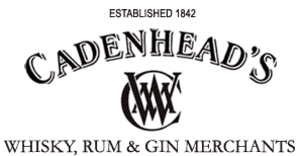
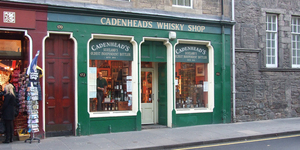
The firm of William Cadenhead Ltd, Wine and Spirit Merchants, was founded in 1842 and is Scotland's oldest independent bottler. The company was was in the ownership of the same family until taken over by J & A Mitchell & Co.Ltd in 1972, the proprietors of Springbank distillery.
For 130 years prior to this, the firm of William Cadenhead Ltd traded from the same premises in the Netherkirkgate, Aberdeen. It was what subsequently became number 47 that Mr George Duncan established himself as a vintner and distillery agent. The business prospered and in little over 10 years he was joined by his brother-in-law Mr William Cadenhead. In 1858 Mr Duncan died following a short illness. William Cadenhead acquired the business and changed the trading name to that of his own. Whilst not much is known of George Duncan, a great deal is on record about his brother-in-law. It must be said that this is not because of his distinction as a vintner but because he was a local poet of renown throughout the Victorian era. Born in 1819, he began working at an early age in a small thread factory where he gained a great deal of respect from his employer. From there he became an overseer in the yarn sorting department of Maberly & Co at their Broadford works, now Richards PLC. About 1853 he left the company and joined his brother-in-law as traveller for Cadenhead's until Duncan's death in 1858 where he acquired the business. Apart from his enviable reputation as a poet, he became a prominent citizen taking part in all aspects of local affairs during his long life.
Early on Sunday morning, 11 December 1904 William Cadenhead died. He was succeeded in the business of Wine and Spirit Merchants at 47 Netherkirkgate by his nephew Robert W. Duthie. He was a quiet unassuming man, unlike his uncle, but developed what the firm became most famous for, namely single malt Scotch whisky and Demerara Rum. He advertised extensively on the back of buses, theatre curtains, concert programmes and in much else under the slogan 'By test the Best'. In addition Mr Duthie developed Cadenhead's brand whiskies, the de-luxe blend Putachieside and the more plebeian name The Heilanman.
In 1931 in the depth of the depression, the business of William Cadenhead was not in good shape financially. Mr Duthie was on his way to a meeting with his bank manager when he was unfortunately run over by a tram car whilst crossing the street. Duthie was a batchelor but left two sisters who knew nothing about the Wine and Spirit trade but were determined that the name of William Cadenhead should survive. Responsibility was handed over to a long term employee, Miss Ann Oliver, an eccentric lady who ran the business exactly as she wanted, refusing to move with the times. However, administration was lax and several bad decisions were made during this time forcing Ms Oliver to retire and sell the business.
Both the bonded and duty paid warehouses were full from the roof to the cellars of stock, the value of which no-one knew nor for which there were any records. In the end Christie's who had liquidated considerable stocks of rum were contacted. The result was a two-day sale of the entire stock and was at that date the largest sale of wines and spirits ever held in Great Britain. The sale took place in London on 3rd and 4th of October 1972 and although there were many bargains, on the whole it was most successful and contrary to expectations it resulted in a six figure surplus over liabilities for the firm.
Thereafter the goodwill, premises etc. of the firm William Cadenhead were sold to J & A Mitchell & Co Ltd., proprietors of Springbank Distillery, one of Scotland's oldest distilleries still owned by descendants of its founder. The name of Cadenhead is now a household name in the whisky world, and the present owners have expanded the Cadenhead business whilst still keeping the goals and traditional methods the firm began with in 1842.
For 130 years prior to this, the firm of William Cadenhead Ltd traded from the same premises in the Netherkirkgate, Aberdeen. It was what subsequently became number 47 that Mr George Duncan established himself as a vintner and distillery agent. The business prospered and in little over 10 years he was joined by his brother-in-law Mr William Cadenhead. In 1858 Mr Duncan died following a short illness. William Cadenhead acquired the business and changed the trading name to that of his own. Whilst not much is known of George Duncan, a great deal is on record about his brother-in-law. It must be said that this is not because of his distinction as a vintner but because he was a local poet of renown throughout the Victorian era. Born in 1819, he began working at an early age in a small thread factory where he gained a great deal of respect from his employer. From there he became an overseer in the yarn sorting department of Maberly & Co at their Broadford works, now Richards PLC. About 1853 he left the company and joined his brother-in-law as traveller for Cadenhead's until Duncan's death in 1858 where he acquired the business. Apart from his enviable reputation as a poet, he became a prominent citizen taking part in all aspects of local affairs during his long life.
Early on Sunday morning, 11 December 1904 William Cadenhead died. He was succeeded in the business of Wine and Spirit Merchants at 47 Netherkirkgate by his nephew Robert W. Duthie. He was a quiet unassuming man, unlike his uncle, but developed what the firm became most famous for, namely single malt Scotch whisky and Demerara Rum. He advertised extensively on the back of buses, theatre curtains, concert programmes and in much else under the slogan 'By test the Best'. In addition Mr Duthie developed Cadenhead's brand whiskies, the de-luxe blend Putachieside and the more plebeian name The Heilanman.
In 1931 in the depth of the depression, the business of William Cadenhead was not in good shape financially. Mr Duthie was on his way to a meeting with his bank manager when he was unfortunately run over by a tram car whilst crossing the street. Duthie was a batchelor but left two sisters who knew nothing about the Wine and Spirit trade but were determined that the name of William Cadenhead should survive. Responsibility was handed over to a long term employee, Miss Ann Oliver, an eccentric lady who ran the business exactly as she wanted, refusing to move with the times. However, administration was lax and several bad decisions were made during this time forcing Ms Oliver to retire and sell the business.
Both the bonded and duty paid warehouses were full from the roof to the cellars of stock, the value of which no-one knew nor for which there were any records. In the end Christie's who had liquidated considerable stocks of rum were contacted. The result was a two-day sale of the entire stock and was at that date the largest sale of wines and spirits ever held in Great Britain. The sale took place in London on 3rd and 4th of October 1972 and although there were many bargains, on the whole it was most successful and contrary to expectations it resulted in a six figure surplus over liabilities for the firm.
Thereafter the goodwill, premises etc. of the firm William Cadenhead were sold to J & A Mitchell & Co Ltd., proprietors of Springbank Distillery, one of Scotland's oldest distilleries still owned by descendants of its founder. The name of Cadenhead is now a household name in the whisky world, and the present owners have expanded the Cadenhead business whilst still keeping the goals and traditional methods the firm began with in 1842.
from Cadenhead
The Distillery: Glen Garioch
| Established: 1797 |
| Silent since: False |
| Address: Distillery Rd., Oldmeldrum, Inverurie AB51 0ES, UK |
| → website |
The Glen Garioch distillery in Aberdeenshire (at times known as the "Old Meldrum" distillery and sometimes spelled as Glengarioch) was built in 1797 by Thomas Simpson. This makes Glen Garioch one of the few remaining distilleries that was founded in the 18th century.
The new owners closed the distillery in October 1995 and re-opened it again in 1997. Rumour has it that Glen Gariochs produced after the closure and reconstruction in 1985 are notably different in character than those that were distilled earlier - and I think I have to agree.
For one thing, the "old style" Glen Gariochs (or at least those distilled between 1973 and 1985) are notably peatier than the more recent "Suntory" expressions that show more fruit. I"ve even been told that Suntory made a intentional effort to change the profile of the Glen Garioch whisky to suit their needs. Judging from the changes that occurred at the Bowmore distillery on Islay after the take-over, this seems like a plausible scenario.
Glen Garioch resumed production again in 1973 when some peated malt whisky is produced. The new owners extended the number of stills from two to three in 1978 and made quite a few other upgrades to the production process, including floor maltings and greenhouses heated by waste heat. A visitor centre was added to the distillery as well.
In 1982 Glen Garioch was the first distillery in Scotland to convert its stills to gas-firing - a move that was followed a few years later by many other whisky distilleries. Two years later (in July 1994) the company Morrison Bowmore Distillers Ltd. was purchased by Suntory from Japan.
The first change in ownership occurred in 1837 when the owners of the nearby Strathmeldrum distillery (John Mason & Co.) bought the Glen Garioch distillery. Strathmeldrum distillery continued to operate until 1884 when it was closed and Glen Garioch was sold to J. G. Thomson & Co of Leith. Details on the decades after that are slightly vague, but early in the 20th century William Sanderson gradually took over control and ownership of Glan Garioch.
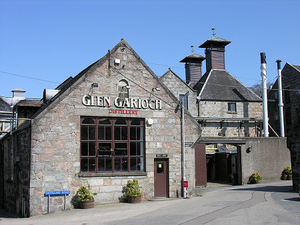
The main reason for Sanderson"s interest in Glen Garioch was the fact that the malt whisky was an important ingredient of the popular VAT69 blend that was introduced by Sanderson in the late 19th century. In 1933 Sanderson & Son (what a lovely name) merged with Booth"s Distilleries Ltd., a company involved in the production of gin. This new company was taken over by the DCL (Distillers Company Limited, a predecessor of Diageo) and then transferred to SMD (Scotch Malt Distillers) in 1943. A little over two dacedes later, in 1968, Glen Garioch distillery was decomissioned & closed. This could have been the end for Glen Garioch, but fortunately Stanley P. Morrison Ltd. stepped in.
As far as equipment goes, Glen Garioch uses a stainless steel (full lauter) mash tun, eight stainless steel washbacks, one wash still and two smaller spirit stills. The malt whisky is matured in both American oak bourbon and European sherry casks.
The official portfolio of Glen Garioch consisted of five different bottlings around the year 2005; a 10 years old, a 15 years old and a 21 years old, as well as two expressions without an age statement; the "Highland Tradition" and the "Archive". After repositioning and restructuring the entire ranges of Bowmore (in 2007) and Auchentoshan (in 2008), it was Glen Garioch"s turn...
2009 - The entire Glen Garioch whisky portfolio is reinvented. The cornerstones of the new range are the 1797 Founder"s Reserve without an age statement and the 12 years old, both bottled at 48% ABV.
Trivia:
1) Glen Garioch distillery was established on the site of an old tannery - and there was probably a brewery in the area as well.
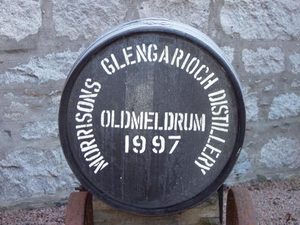
2) In November 1972 Glen Garioch was released as a single malt for the first time. Previously the malt whisky had only been used in blends such as VAT 69, Bell"s, Grant"s Standfast - as well as the liqueur Drambuie.
In 2009, the 1797 Founder"s Reserve (depicted at the left, no age statement) and a 12 years old "standard" expression are released, along with two vintages; a 1978 and a 1990. One curious feature of both the "Founder"s Reserve" and 12yo expressions is the unusual ABV of 48%. As far as I know, no other whisky brand uses that ABV for any official bottling...
In the New Millenium
2004 - The oldest official bottling ever of Glen Garioch is released; the Glen Garioch 46yo 1958/2004 (43%, OB). The malt whisky in the cask was distilled in May 1958; in September 2004 no more than 336 bottles were filled.
2005 - The Glen Garioch visitor centre is opened in October.
from Malt Madness
The Owner: Morrison Bowmore Distillers
| Established: 1951 |
| Silent since: False |
| Address: Springburn Bond, Carlisle Street, Glasgow G21 1EQ, United Kingdom |
| → website |
With three Malt Whisky Distilleries situated in the major production areas of Islay, the Highlands and the Lowlands and significant blending, bottling and warehousing facilities, the company has established a leading role in the export of Bulk blend, Vatted Malt and in particular `Bottled in Scotland" Blends and Single Malts.
Morrison Bowmore Distillers acquired Bowmore in 1963, Glen Garioch in the early 70s and Auchentoshan in the 80s. Suntory acquired Morrison Bowmore Distillers and its distilleries in 1994.

Founded in 1951 by Mr Stanley P Morrison and Mr J Howat, Morrison Bowmore Distillers Limited is now a wholly owned subsidiary of Suntory Limited and is one of the major names in Scotch whisky.
from Morrison Bowmore Distillers, Malt Maniacs
The Owner: Suntory
| Established: 1899 |
| Silent since: False |
| Address: Daiba 2-3-3, Minato-ku, Tokyo, 135-8631, Japan |
| → website |
In 2003, Suntory acquired a 98.5% equity holding in Florigene. Prior to this, Florigene had been a subsidiary of global agrochemicals giant Nufarm Limited since 1999. In July 2004, Suntory and Florigene scientists announced to the world the development of the first roses containing blue pigment, an important step toward the creation of a truly blue colored rose.
On April 1, 2009, Suntory became a stockholding company named "Suntory Holdings Limited and established "Suntory Beverage and Food Limited", "Suntory Products Limited", "Suntory Wellness Limited ", "Suntory Liquors Limited", "Suntory Beer & Spirits Limited", "Suntory Wine International Limited", and "Suntory Business Expert Limited".

From the early 1990s, Suntory has collaborated extensively with Melbourne biotechnology firm Florigene to genetically engineer the world"s first true blue rose, a symbol often associated with the impossible or unattainable. In 1991, the team won the intense global race to isolate the gene responsible for blue flowers, and has since developed a range of genetically modified flowers expressing colors in the blue spectrum, as well as a number of other breakthroughs extending the vase life of cut flowers.
Suntory was started by Torii Shinjiro, who first opened his store Torii Shoten in Osaka on February 1, 1899, to sell imported wines. In 1907, the store began selling a sweet tasting red wine called Akadama Port Wine. The store became the Kotobukiya company in 1921 to further expand its business. In December 1924, Yamazaki Distillery, the first Japanese whisky distillery, began its production of malt whisky. Five years later Suntory Whisky Sirofuda (White Label), the first single malt whisky made in Japan, was sold.

Due to wartime shortage of World War II, Kotobukiya was briefly forced to halt its development of new products. In 1961, Kotobukiya launched the famous "Drink Tory"s (Whisky) and Go to Hawaii" campaign. At the time, a trip abroad was considered a once-in-a-lifetime opportunity. In 1963, Kotobukiya changed its name to "Suntory", taken from the name of the famous whisky it produces. In the same year, Musashino Beer Factory began its production of the Suntory Beer. In 1997, the company became Japan"s sole bottler, distributor, and licensee of Pepsi products.
Suntory is a Japanese brewing and distilling company group. Established in 1899, it is one of the oldest companies in the distribution of alcoholic beverages in Japan. Its business has expanded to other fields, and the company now offers everything from soft drinks to sandwich chains. Suntory is headquartered in Dojimahama Nichome, Kita-ku, Osaka, Osaka prefecture.
Trivia:
- On July 14, 2009, Kirin announced that it is negotiating with Suntory on a merger. On February 8, 2010, it was announced that negotations between the two were terminated.
- Suntory was one of the first Asian companies to specifically employ American celebrities to market their product. One of the most notable is Sammy Davis, Jr., who appeared in a series of memorable Suntory commercials in the early 1970s. In the late 1970s, Akira Kurosawa directed a famous series of commercials featuring American celebrities on the set of his film Kagemusha. One of these featured Francis Ford Coppola (an executive producer of the film), which later inspired his daughter Sofia Coppola in her writing of Lost in Translation, a film which focuses on an American actor filming a Suntory commercial in Tokyo.
- Suntory operates two museums, the Suntory Museum of Art in Tokyo and the Suntory Museum Tempozan in Osaka, in addition to a number of cultural and social programs across Japan.
- There is a top Japanese rugby club called the Suntory Sungoliath owned by the Suntory company.
from Wikipedia
The Owner: Springbank
| Established: 1828 |
| Silent since: False |
| Address: 85 Longrow, Campbeltown PA28 6EX, United Kingdom |
Springbank Distillery is one of the last surviving producers of Campbeltown Single Malts. The distillery, located on the southern Kintyre peninsula, produces three distinct types of single malt Scotch whisky. These are branded as Springbank, Longrow and Hazelburn Single Malt. Springbank itself is the most popular variety, a two and a half times distilled non-chillfiltered single malt. Longrow is a highly peated single malt available in Bourbon, Sherry and an experimental Tokaji cask maturation. Hazelburn has only been produced at Springbank since 1997, is fully triple distilled and comes in a 8yo and 12yo variety.
2000 - The 10yo official bottling that hadn"t been available for a number of years is re-launched. This was roughly around the same time Signatory dropped of my shopping list; the price difference with the old 21yo was minimal. In the same year the first official bottling or Longrow with an age statement is released; the Longrow 10yo.
In the new Millenium
2008 - Early in the Summer some shocking news starts to leak out about the imminent mothballing of the Springbank distillery - at least for part of the year. Part of the staff is laid off because Springbank would produce significantly less whisky than usual in 2009. From what I understand, the Glengyle distillery will be closed as well. Apparently, the owners felt that they had sufficient whisky stocks for now. That"s a little odd, because for many years they claimed that they could keep raising their prices because they didn"t have enough stocks to satisfy demand anyway.
2005 - The first official bottling of Hazelburn is released with an age statement of eight years.
I"ve had the pleasure of sampling some fabulous older Springbanks, but by the time I had grown really mad about single malts, most of the "better" expressions were already priced well outside my financial comfort zone. So, Springbank never grew into a real favourite of mine, although the 21yo that was available at the end of the 1990"s (pictured above) was fantastic. Better yet, it was relatively modestly priced at less than 100 guilders.
Unlike its previous owner, the Glen Scotia distillery has managed to survive to this day. For many years it was the only remaining Campbeltown distillery, apart from their neighbours at Springbank of course. In fact, for a few years the relations between Springbank and Glen Scotia were extra neighbourly because a crew from Springbank came over to the Glen Scotia distillery every now and then to produce a little whisky (to keep the equipment in shape).
For many years the owners of Springbank claimed they could set such steep prices for their whisky because they didn"t have enough stocks to satisfy demand anyway. In such a (financially comfortable) climate it is hardly surprising that they (sort of) reconstructed the old Glengyle distillery a few years ago so they could increase production capacity. Unfortunately, a few years later the economical winds changed; Springbank & Glengyle were (temporarily) closed.
Even at that time, most Springbanks were released as expensive "ultra premium" bottles. As a result, a lot of them were exported to the USA - the country where massclusivity was invented and where many customers are sensitive to status. Or rather: the perception of status - which in turn is often linked to the price that has to be paid for certain products. America is not unique in that respect though - these misconceptions exist elsewhere too.
2010 - At the end of the 1990"s and during most of the noughties the prices for Springbank official bottlings were much higher than those for other, comparable single malt whiskies. After the brief mothballing of the distillery, their prices seemed much more in line with other Scotch single malts. (Or rather: most other brands had caught up ;-)

2009 - Springbank resumes part-time production again; 3 months of malting followed by 3 months of distillation.
Three years later in 1828 Springbank was built on the site of the older Archibald"s illegal still.
The quality of Springbank whisky became well enough known for in 1838 a certain John Walker of Kilmarnock to buy, in 1838, 118 gallons at 8s 8d (43p) a gallon.
The Mitchells first came to Campbeltown in the mid 17th century as settlers from the lowlands, some of whom were already maltsters. The story of Springbank begins a century later with the great-grandfather of the distillery"s current managing director. Archibald Mitchell, the son of a farmer married a cousin and learnt from his father-in-law (and uncle!) the art of malting. He also later acquired the art of distilling, though never the one of buying a licence. It was his sons Hugh, Archibald, John and William plus daughter Mary who took up distilling as a legal pursuit.
The first venture was Rieclachan Distillery in 1825 in which Archibald the younger was an original partner, and he was soon joined by Hugh.
Springbank is one of only two distilleries in Scotland to perform every step in the whisky making process, from malting the barley to bottling the spirit, on same premises: the other is Kilchoman Distillery who also grow their own barley. While a few others still maintain the first step in the process, the malting of barley (which is becoming more rare), Springbank also bottles their own whisky. The distillery is also one of the most inactive, having stills operating less than a third of the time.
Springbank is one of the few remaining family owned distilleries. Perhaps it is for this reason that nearly all of its whisky is sold as a single malt, with little of it finding its way into blends. Most blends are produced by larger conglomerates who tend to use the single malts from the distilleries that they own in their blends. Springbank produces two of its own blends, 5 year old Campbeltown Loch, and Mitchell"s 12 year old.
As distillery after distillery set up in Campbeltown, with the demand for malts from this area appearing insatiable, the business of the Mitchell family stretched further. John bought out the Toberanrigh Distillery built by cousin Alexander Wylie, while his sister Mary built Drumore Distillery in 1834 and William founded Glengyle in 1872.
Already in the late nineteenth century, Campbeltown whisky was of the highest quality and in enormous demand by blenders. Before the turn of this century it was highly peated and only short of being Islay in style. In the early part of this century the fashion in whisky moved away from these heavier types of whisky and Springbank altered accordingly, with malt being dried over coal rather than peat.
Barnard"s Campbeltown was a very different town from today"s, though. During the glory days of the town and the tip of the Kintyre peninsula, more that thirty distilleries were active in the area. Campbeltown was also known as "The Whisky Capital of the World". However, most of the distilleries were focused on quantity rather than quality because they were not able to keep up with the demand for their malt whiskies (especially from the US) anyway. So there was no incentive to try and improve the Campbeltown whiskies...
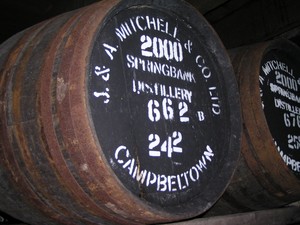
This attitude came back to haunt the Campbeltown distillers when Western economies were hit by an international recession after World War I and the prohibition in the USA brought (legal) exports to the America"s to a virtual standstill. One of the first victims was the Glengyle distillery, built circa 1873 by William Mitchell after a fight with his brother John at Springbank. The distillery closed down again in 1825 - and many other Campbeltown distilleries followed. The economical downturn proved to have disastrous consequences for the "volume" whisky distilleries in Campbeltown. The owner of the Glen Scotia distillery became so depressed that he drowned himself in the artificial lake that was constructed as the distillery"s water supply. Some people say his ghost still haunts the buildings...
Whisky is liquid courage. Many people - mostly men - have performed acts of inspired bravery (and foolishness) whilst under the influence of "the water of life". And while the cheaper blends and bourbons usually affect the more primitive parts of the brain (truncus cerebri), it seems single malts often appeal to the higher brain functions in the cerebrum.
So, while the symptoms of low budget alcohol abuse often include primitive behavior like shouting and brawling, those of us that prefer to abuse our alcohol in style find ourselves inspired to start writing books, composing music or plan a voyage to Scotland where the whisky was made. Travellers that have the time and means to stay for a few days can visit all the main whisky producing regions and one of its distilleries.
However, from a traveller"s perspective, visiting the Campbeltown area is a small nightmare. One has to make a long trek to the Southern tip of the Kintyre peninsula on the Western coast of Scotland to reach Springbank - or the nearby Glen Scotia distillery. Except for the distilleries, there"s not much happening in Campbeltown. And even for the people that want to "get away from it all" for a few days, Springbank is a fairly poor destination. It"s one of the few distilleries that isn"t surrounded by the lush Scottish countryside - located in the middle of a busy town.
Many distilleries welcome visitors with open arms, but when some of the maniacs visited Springbank in 2005 they didn"t seem very pleased to see us - or the other visitors for that matter. So, for me the best thing of the trip was the night I spent in the same hotel that Alfred Barnard stayed in when he visited the area over a century ago.
With the success of a nearby coal mine, fuel to run the distilleries was plentiful and cheap. And profits for the distillers were handsome. All the major distilling dynasties in the town, the Colvilles, Mitchells, Mactaggarts and Fergusons built large gentlemen"s houses in keeping with the money pouring into the bank accounts and the newfound status of respectability they had acquired. By 1891, Campbeltown with a population of just 1,969 was reputed to be the richest town per capita in Britain.
But every bubble bursts. And in the 1920s, with one or two notable exceptions, distillers in the town had begun cutting corners in the making of their whisky to meet the demand.
Soon blenders began to turn their backs on Campbeltown and looked for consistently better malt elsewhere. Only Springbank, Glen Scotia and Rieclachan maintained their quality and their order books open as one by one the other distilleries fell by the wayside.
In 1934 it was decided to close Rieclachan, leaving only Springbank and Glen Scotia, as is the case today.
Trivia:
- Springbank distillery was built in 1828 by two brothers, Archibald and Hugh Mitchell. Rumour has it that their father had already been running an illegal distillery at the same location for years. The Springbank distillery is still owned by the Mitchell family - and so is the (sort of) reconstructed Glengyle distillery.
- Apart from the "Springbank" brand the distillery produces two other "deluxe" brands, Hazelburn and Longrow.
- Frank McHardy has been working at the distillery for many years; Helen Arthur"s guide from the 1990"s already lists him as distillery manager and he was still involved with Springbank when it (temporarily) closed down in 2008. url="http://www.springbankdistillers.com"
from Wikipedia, Malt Madness
